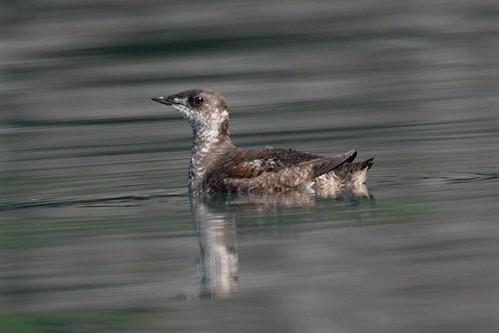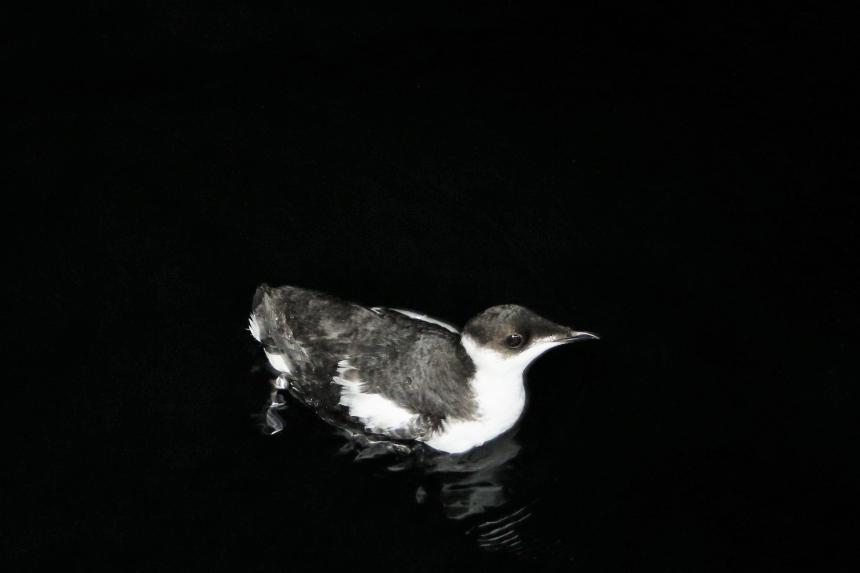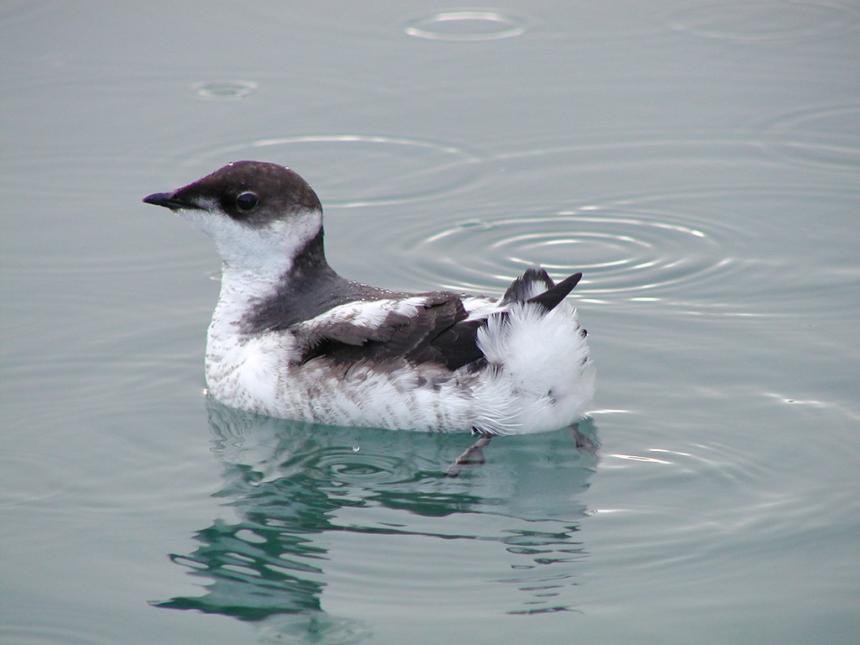Moderate
The marbled murrelet population in Washington is low and declining. Because of its breeding association with old forests, their populations have been severely affected by loss of mature and old forest habitat. Food resources in the marine environment may also influence population status.
Description and Range
Physical description
The marbled murrelet is a small (10 inches in length), chunky seabird. Its beak is black and slender. Breeding plumage has an overall brownish ‘marbled’ look. Adult non-breeding plumage is a black crown with a white ear patch, throat and underside, black nape and back, and black wings with white scapulars (top of wing). Juvenile plumage is similar to adult non-breeding but duskier overall.
Ecology and life history
Marbled murrelets are seabirds that forage in marine waters but nest in forests. In Washington, marbled murrelets nest in mature and old-growth conifer forests, and sometimes in comparatively younger forests with residual old-growth trees. They locate their nest in a depression on a mat of moss, lichen or debris accumulations on large branches. Marbled murrelets appear to establish long-term pair bonds and fidelity to nesting areas and nest trees.
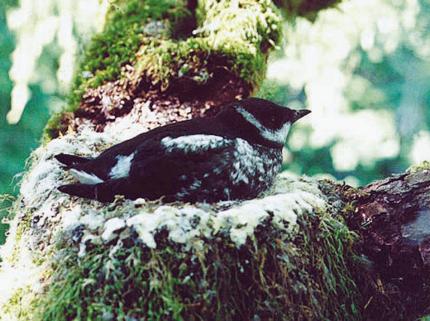
Small schooling fish (such as Pacific anchovy, Pacific herring, candlefish, and Pacific sand lance) make up most of the diet, which may include small crustaceans when fish are not abundant. Marine foraging areas are usually within 1.2 to 3 miles of shore, typically in waters less than 100 feet deep.
Geographic range
The marbled murrelet inhabits the nearshore marine environment in western North America. In Washington, this species is an uncommon resident. It is found in marine waters in general proximity to nesting habitat. It is most abundant in northern Puget Sound and the Strait of Juan de Fuca, and least abundant along the coast of southwestern Washington. The primary factor influencing breeding distribution is likely the availability of suitable nesting "platforms" (such as large branches) within close proximity to marine water foraging areas.
Surveys indicate highest nesting presence is on the Olympic Peninsula, the northern Cascades and in limited remaining habitat in southwest Washington. At-sea population monitoring from 2001 to 2015 indicated a 4.4% decline in the murrelet population annually, which represents a 44% reduction since 2001. The 2015 population estimate for Washington is about 7,500 birds. Sustained low juvenile recruitment has been identified as a main cause of the decline.
For a map of range-wide distribution and conservation status of this species, check out NatureServe Explorer.
Climate vulnerability
Sensitivity to climate change
Moderate
The main sensitivities of marbled murrelets to climate change will likely be due to potential changes in prey availability and habitat. Increasing sea surface temperatures could lead to declines in target prey abundance (e.g., herring, sand lance, crustaceans) and declines in murrelet productivity, though their ability to target multiple types of prey may help this species adapt to shifts in prey abundance. Alterations in nesting habitat, which occurs in inland mature and old growth forests, could also lead to declines in populations. Potential increased storminess and higher winds could impact nesting sites, as could drier, warmer conditions that lead to increased fires and more fragmented habitat for nesting.
Exposure to climate change
Moderate
- Increased ocean temperatures
- Increased storminess and winds
- Altered fire regimes
Conservation
Conservation Threats and Actions Needed
- Fish and wildlife habitat loss or degradation
- Threat: Conversion of old forest nesting habitat to commercial forestry. Fragmentation of nesting habitat isolates remaining breeding areas, increases hard edge (attracting predators), and decreases nest success.
- Action Needed: Use land acquisitions, conservation easements and landowner agreements to protect nesting habitat and create larger contiguous forest blocks.
- Management decision needs
- Threat: Conversion of old forest nesting habitat to commercial forestry. Fragmentation of nesting habitat isolates remaining breeding areas, increases hard edge (attracting predators), and decreases nest success.
- Action Needed: Identify and retain future potential recruitment habitat near and adjacent to currently occupied sites. Block and connect forests to reduce edge with "security forest" goal of more than 40 years old adjacent to nesting habitat. Increase nearshore terrestrial habitat.
- Resource information collection needs
- Threat: Chronic low juvenile recruitment in a declining population.
- Action Needed: Collect data needed for comprehensive understanding of demography.
- Fish and wildlife habitat loss or degradation
- Threat: Campgrounds/recreation sites in and near habitat can attract avian predators (corvids) and human disturbance to nesting birds.
- Action Needed: Outreach and education to enhance refuse management at campgrounds; develop visitor management guidelines for murrelet breeding areas.
- Energy development and distribution
- Threat: Environmental contamination in marine habitat; very vulnerable to periodic and chronic spills that may have lethal and sub-lethal effects that affect populations.
- Action Needed: Control, monitor, and timely response to contaminant (oil) spills. Identify important nearshore foraging areas and include in spill response team's maps/databases.
See the Climate vulnerability section for information about the threats posed by climate change to this species.
Our Conservation Efforts
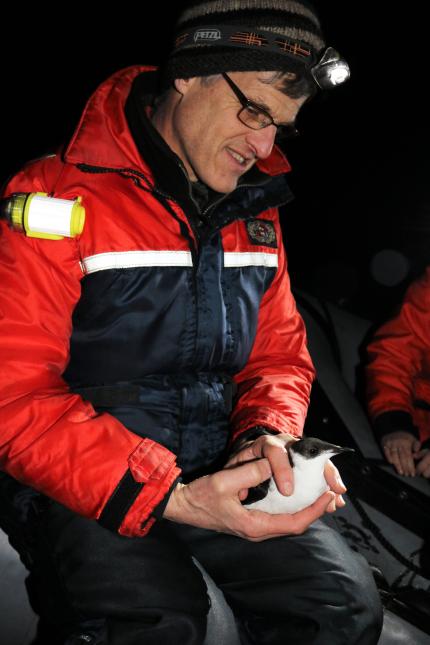
At-Sea Marbled Murrelet Population Monitoring
Since 2000, WDFW has joined USDA Forest Service Pacific Northwest Research Station, U.S. Fish and Wildlife Service, and other state, federal and private researchers to participate in a program to estimate marbled murrelet population size and trends during the breeding season between San Francisco Bay and Washington state. This effort provides the only information available to assess population size and trends in this geographic area for this species. Learn more about this research and access progress reports on the Marine birds page. This page also includes information about other projects, including at-sea marbled murrelet research involving the U.S. Navy.
Midwinter Aerial Seabird Surveys
WDFW conducts survey flights over a period of several days from November through February annually to monitor the abundance, trends, and distribution of sea ducks and other marine birds, including marbled murrelets, in the Puget Sound and the Strait of Juan de Fuca (U.S. portion of the Salish Sea). Learn more about this research on the project's page.
Marbled Murrelet Diet Research
From 2017 to 2019, WDFW, in collaboration with U.S. Fish and Wildlife Service, USDA Forest Service, and the University of Wisconsin, captured marbled murrelets on the water at night using a spotlight technique. This technique allows for capture of birds mesmerized by the light; during the day, capture would be more difficult as they normally dive or fly away well in advance of a boat’s approach. The goal of the project is to gain a better understanding of marbled murrelet diet during the non-breeding season. To reconstruct diet, murrelets were captured and a fecal sample collected if provided by the bird. Next generation sequencing of the DNA in the feces is used to determine what the murrelet was eating. It is hoped this information will help identify important components of murrelet diet and also help focus future efforts on protecting those critical food resources. Additional work is slated for 2020, with planned modifications for positioning of boats and crew to address concerns regarding COVID-19. A manuscript summarizing findings is anticipated in early 2021.
Resources
References
Ralph, C. J., G. L. Hunt, M. G. Raphael, and J. F. Piatt (technical editors). 1995. Ecology and conservation of the Marbled Murrelet. Gen. Tech. Rep. PSW-GTR-152. Albany, California.
Raphael, M. G., A. Shirk, G. A. Falxa, S. F. Pearson. 2014 Habitat associations of marbled murrelets during the nesting season in nearshore waters along the Washington to California coast. Journal of Marine Systems. DOI: 10.1016/j.jmarsys.2014.06.010
WDFW publications
Status reports
- Periodic Status Review for the Marbled Murrelet in Washington (2016)
- Status of the Marbled Murrelet (Brachyramphus marmoratus) in Washington (1993)
Other resources
- U.S. Fish and Wildlife Service - Species Profile: Marbled Murrelet
- Northwest Forest Plan - Marbled Murrelet Monitoring Program
- Marbled Murrelet habitat, forest practices and survey guidance
- eBird Northwest - Marbled Murrelet;
- Cornell Lab All About Birds - Marbled Murrelet
